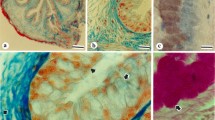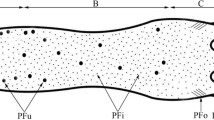Summary
Taste buds in the European catfish Silurus glanis were examined with electron microscopic lectin histochemistry. For detection of carbohydrate residues in sensory cells and adjacent epithelial cells, gold-, ferritin-and biotin-labeled lectins were used. A post-embedding procedure carried out on tissue sections embedded in LR-White was applied to differentiate between the sensory cells: The lectins from Helix pomatia (HPA) and Triticum vulgare (WGA) bound to N- acetyl-galactosamine and to N-acetylglucosamine residues occurring especially in vesicles of dark sensory cells. This indicates a secretory function of these cells. Most light sensory cells — with some exceptions, probably immature cells —, are HPA-negative. The mucus of the receptor field and at the top of the adjacent epithelial cells was strongly HPA-positive. Pre-embedding studies were performed in order to obtain information about the reaction of the mucus with lectins under supravital conditions. The mucus of the taste bud receptor field exhibited intensive binding to WGA, but not to the other lectins tested. Most lectins bound predominantly to the surface mucus of the nonsensory epithelium and to the marginal cells close to the receptor field. The strong lectin binding to mucins and the relatively weak lectin binding to cell surface membranes in pre-embedding studies suggest that the mucus possibly serves as a barrier which is passed selectively only by a small amount of lectins or lectincarbohydrate complexes. Lectin-carbohydrate interactions may play a role in recognition phenomena on the plasmalemmata of the taste bud sensory cells. Recognition processes directed to bacteria or viruses should be considered as well.
Similar content being viewed by others
References
Bannister LH (1974) Possible functions of mucus at gustatory and olfactory systems. In: Poynder TM (ed) Transduction mechanisms in chemoreception. Information Retrieval, London, pp 39–48
Baker DA, Sugii S, Kabat EA, Ratcliffe RM, Hermentin P, Lemieux RU (1983) Immunohistochemical studies on the combining sites of Forssman Hapten reactive hemagglutinins from Dolichos biflorus, Helix pomatia, and Wistaria floribunda. Biochemistry 22:2741–2750
Bryant BP, Brand G, Kalinoski DL, Bruch RC, Cagan RH (1986) Use of monoclonal antibodies to characterize amino acid taste receptors in catfish: effects on binding and neural responses. Chem Senses 11:586 (Abstract)
Caprio J, Byrd RP Jr (1984) Electrophysiological evidence for acidic, basic, and neutral amino acid olfactory receptor sites in the catfish. J Gen Physiol 84:403–422
Chen Z, Pace U, Ronen D, Lancet D (1986) Polypeptide GP 95: a unique glycoprotein of olfactory cilia with transmembrane receptor properties. J Biol Chem 261:1299–1305
Delay RJ, Kinnamon JC, Roper SD (1980) Ultrastructure of mouse vallate taste buds. II. Cell types and cell lineage. J Comp Neurol 253:242–252
Debray H, Decout D, Stecker G, Spik G, Montreuil J (1981) Specificity of twelve lectins towards oligosaccharides and glycopeptides related to N-glycosyl-proteins. Eur J Biochem 117:41–55
Desgranges JC (1965) Sur l'existence de plusieurs types de cellules sensorielles dans les bourgeons du goût des barbillons du Poisson-chat. CR Acad Sci (Paris) 261:1095–1098
Ellinger A, Pavelka M (1985) Post-embedding localization of glycoconjugates by means of lectins on thin sections of tissues embedded in LR white. Histochem J 17:1321–1336
Farbman AI, Ogden-Ogle CK, Hellekant G, Simmons SR, Albrecht RM, van der Wel H (1987) Labeling of sweet taste binding sites using a colloidal gold-labeled sweet protein, Thaumatin. Scanning Microsc 1:351–357
Frens G (1973) Controlled nucleation for the regulation of particle size in monodisperse gold suspensions. Nature Phys Sci 241:20–22
Gabius HJ, Engelhardt R, Cramer F (1986) Endogenous tumor lectins: overview and perspectives. Anticancer Res 6:573–578
Goldstein IJ, Hayes CE (1978) The lectins: carbohydrate binding proteins of plant and animals. Adv Carbohydr Chem Biochem 35:127–340
Goldstein IJ, Peretz RD (1986) Isolation and chemical properties of lectins. In: Liener E, Sharon N, Goldstein IJ (eds) The lectins. Properties, functions, and applications in biology and medicine. Academic Press, New York, pp 35–244
Grover-Johnson N, Farbman AI (1976) Fine structure of taste buds in the barbel of the catfish, Ictalurus punctatus. Cell Tissue Res 169:395–403
Horisberger M (1983) The gold method as applied to lectin cytochemistry in transmission and scanning electron microscopy. In: Bullock GR, Petrusz P (eds) Techniques in immunocytochemistry, vol 3. Academic Press, New York, pp 155–178
Holland KN, Teeter JH (1981) Behavioral and cardiac reflex assays of the chemosensory acuity of channel catfish to amino acids. Physiol Behav 27:699–707
Jones CJP, Stoddard RW (1986) A post-embedding avidin-biotin peroxidase system to demonstrate the light and electron microscopic localization of lectin binding sites in rat kidney tubules. Histochem J 18:371–379
Kalinoski DL, Bruch RC, Brand JG (1987) Differential interaction of lectins with chemosensory receptors. Brain Res 418:34–40
Kalinoski DL, Johnson LC, Brand JG (1989) Selective interactions of lectins with amino acid taste receptor sites of the channel catfish. Chem Senses 14:716 (Abstract)
Key B, Giorgi PP (1986) Selective binding of soybean agglutinin to the olfactory system of Xenopus. Neuroscience 18:505–515
Kinnamon S (1988) Taste transduction: a diversity of mechanisms. Trends Neurol Sci 11:491–496
Kornfeld R, Kornfeld S (1980) Structure of glycoprotein and their oligosaccharide units. In: Lennarz WJ (ed) The biochemistry of glycoproteins and proteoglycans. Plenum Press, New York London, pp 1–34
Lotan RE, Skutelsky E, Danon D, Sharon N (1975) The purification, composition, and specificity of the anti-T lectin from peanut (Arachis hypogaea). J Biol Chem 250:8518–8523
Lum CKL, Henkin RI (1976) Sugar binding to purified fractions from bovine taste buds and epithelial tissue. Biochim Biophys Acta 421:380–394
Lundh B, Brockstedt U, Kristensson K (1989) Lectin-binding pattern of neuroepithelial and respiratory epithelial cells in the mouse nasal cavity. Histochem J 21:33–43
Luther P, Noack K, Reutgen H (1988) Lectins and their role in a new polyvalent bacterial vaccine against ARI. Zentralbl Bakteriol Mikrobiol Hyg [A] 270:16–21
Newman GR, Hobot JA (1987) Modern acrylics for post-embedding immunostaining techniques. J Histochem Cytochem 35:971–981
Ofek I, Sharon N (1988) Lectinophagocytosis: a molecular mechanism of recognition between cell surface sugars and lectins in the phagocytosis of bacteria. Infect Immun 56:539–547
Pevsner J, Reed RR, Feinstein PG, Snyder SH (1988) Molecular cloning of odorant-binding protein: member of a ligand carrier family. Science 241:336–339
Plendl J, Schmahl W (1988) Dolichos biflorus agglutinin: a marker of the developing olfactory system in the NMRI-mouse strain. Anat Embryol 177:459–464
Reutter K (1978) Taste organ in the bullhead (Teleostei). Adv Anat Embryol Cell Biol 55:1–98
Reutter K (1986) Chemoreceptors. In: Bereiter-Hahn J, Matoltsy AG, Richards KS (eds) Biology of the integument, vol 2, vertebrates. Springer, Berlin Heidelberg New York, pp 586–604
Reutter K (1987) Specialized receptor villi and basal cells within the taste bud of the European Silurid fish, Silurus glanis (Teleostei). In: Roper SD, Atema J (eds) Olfaction and taste IX, vol 510. New York Academy of Sciences, New York, pp 570–573
Reutter K, Klessen Ch (1979) Vergleichend-kohlenhydrathistochemische Untersuchung der Geschmacksknospen niederer und höherer Wirbeltiere. Verh Anat Ges 73:1019–1021
Roper SD (1989) The cell biology of vertebrate taste receptors. Annu Rev Neurosci 12:329–359
Roth J (1983) Application of lectin-gold complexes for electron microscopic localization of glycoconjugates on thin sections. J Histochem Cytochem 31:987–999
Roth J (1984) Cytochemical localization of terminal N-Acetyl-d-galactosamine residues in cellular compartments of intestinal goblet cells: implications for the topology of O-glycosylation. J Cell Biol 98:399–406
Schmale H, Holtgreve-Grez H, Christiansen H (1990) Possible role for salivary gland protein in taste reception indicated by homology to lipophilic-ligand carrier protein. Nature 343:366–369
Schulte BA, Spicer SS (1984) Light microscopic detection of sugar residues in glycoconjugates of salivary glands and the pancreas with lectin-horseradish peroxidase conjugates. II. Rat. Histochem J 16:3–20
Sharon N, Lis H (1972) Lectin-agglutinating and sugar-specific protein. Science 177:949–959
Suganuma T, Tsuyama S, Murata F (1985) Glycoconjugate cytochemistry of the rat fundic gland using lectin/colloidal-gold conjugates and Lowicryl K4M. Helix pomatia lectin is a specific marker for mucous neck cells in fundic glands of the rat gastric mucosa. Histochemistry 83:489–495
Uhlenbruck G (1987) Bacterial lectins: mediators of adhesion. Zentralbl Bakteriol Microbiol Hyg [A] 263:497–508
Wasano K, Kim KC, Niles RM, Brody JS (1988) Membrane differentiation markers of airway epithelial secretory cells. J Histochem Cytochem 36:167–178
Winberg J (1984) P-fimbriae, bacterial adhesion, and pyelonephritis. Arch Dis Child 59:180–184
Witt M, Reutter K (1988) Lectin histochemistry on mucous substances of the taste buds and adjacent epithelia of different vertebrates. Histochemistry 88:453–461
Witt M, Reutter K (1989) Electron microscopical demonstration of lectin binding at taste buds and surface mucus of the barbels of Silurus glanis (Teleosts). A pre-embedding and post-embedding study. Chem Senses 14:761–762 (Abstract)
Wohlfarth-Bottermann KE (1957) Die Kontrastierung tierischer Zellen und Gewebe im Rahmen ihrer elektronenmikroskopischen Untersuchung an ultradünnen Schnitten. Naturwissenschaften 44:287–288
Zaccone G, Lo Cascio P, Fasulo S, Licata A (1985) The affect of an anionic detergent on complex carbohydrates and enzyme activities in the epidermis of the catfish Heteropneustes fossilis (Bloch). Histochem J 17:453–466
Zuchelkowski EM, Pinkstaf CAF, Hinton DE (1985) Mucosubstance histochemistry in control and acid-stressed epidermis of brown bullhead catfish, Ictalurus nebulosus (Le Sueur). Anat Rec 212:327–335
Author information
Authors and Affiliations
Rights and permissions
About this article
Cite this article
Witt, M., Reutter, K. Electron microscopic demonstration of lectin binding sites in the taste buds of the European catfish Silurus glanis (Teleostei). Histochemistry 94, 617–628 (1990). https://doi.org/10.1007/BF00271989
Accepted:
Issue Date:
DOI: https://doi.org/10.1007/BF00271989




